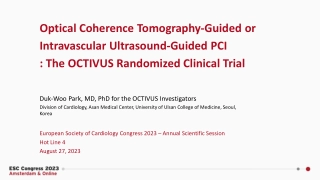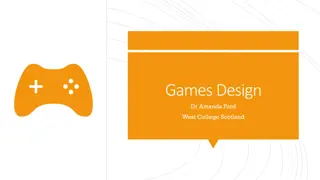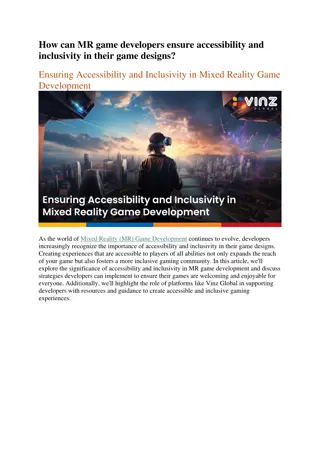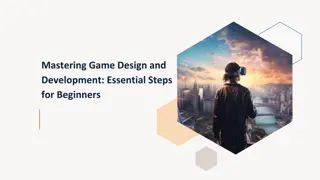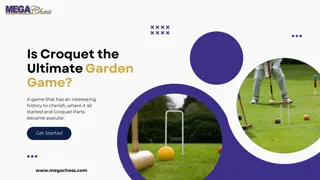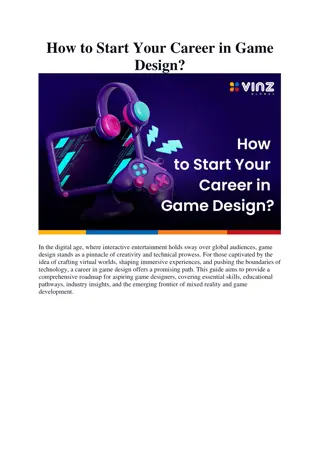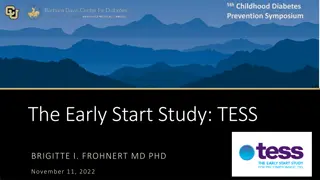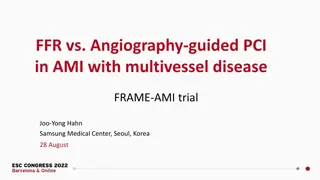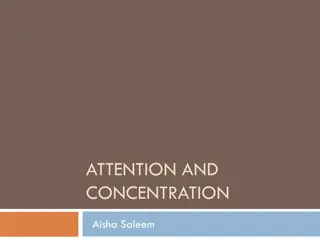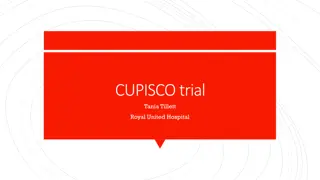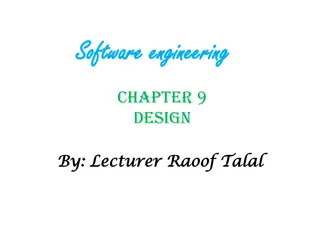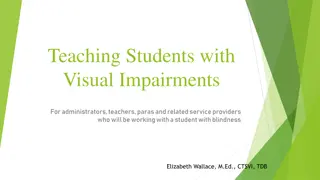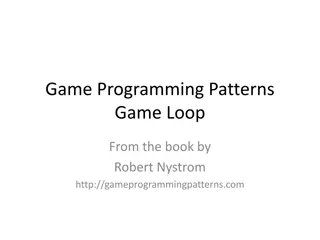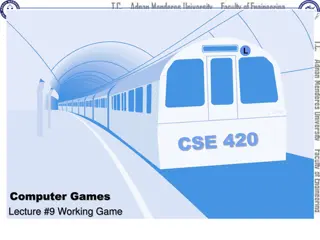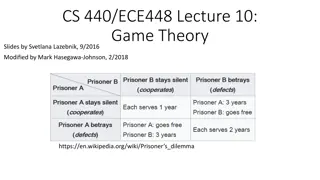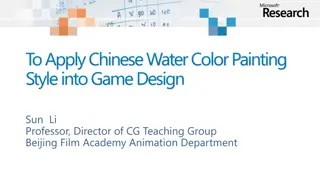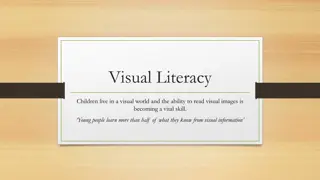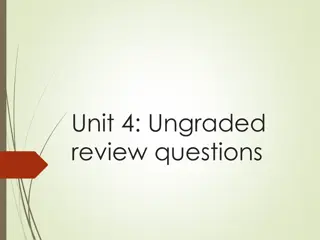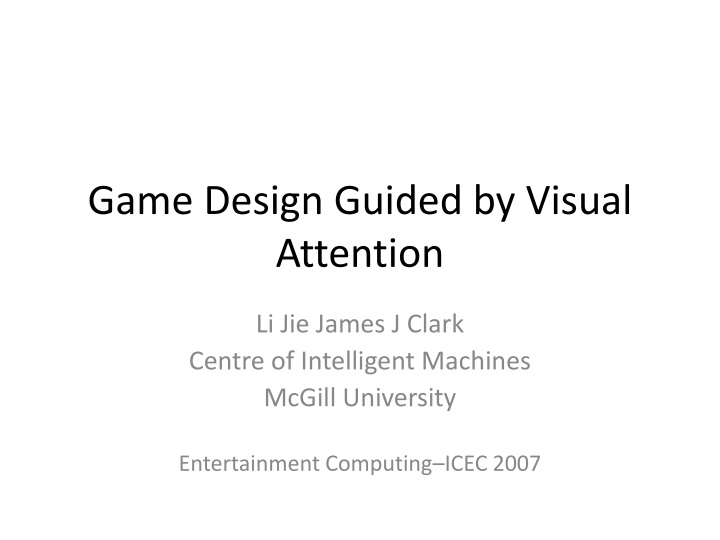
Game Design Enhanced by Visual Attention Allocation
This study explores how understanding visual attention allocation can improve game design by attracting and controlling players' attention levels. The authors propose a method to estimate attention allocation using eye movement and image data. The experiment involved analyzing image complexity at fixation points to study attention disengagement. Male and female participants used an eye tracker to record eye positions, and image entropy was computed to analyze the information quantity in images. Overall, the research aimed to inform game designers on how to engage players effectively.
Download Presentation

Please find below an Image/Link to download the presentation.
The content on the website is provided AS IS for your information and personal use only. It may not be sold, licensed, or shared on other websites without obtaining consent from the author. If you encounter any issues during the download, it is possible that the publisher has removed the file from their server.
You are allowed to download the files provided on this website for personal or commercial use, subject to the condition that they are used lawfully. All files are the property of their respective owners.
The content on the website is provided AS IS for your information and personal use only. It may not be sold, licensed, or shared on other websites without obtaining consent from the author.
E N D
Presentation Transcript
Game Design Guided by Visual Attention Li Jie James J Clark Centre of Intelligent Machines McGill University Entertainment Computing ICEC 2007
Introduction Better understanding of allocation of visual attention can benefit design of game scenarios Studies of visual attention can inform game designers how to attract and avoid players attention, which enables designers to control different game levels The authors propose a way to estimate task-dependent attention allocation based on eye movement information with image information
Methods First experiment: detect if image complexity at fixation point affected disengagement of attention during fixation and pursuit conditions Environment: a computer, a screen of 1280*1024 pixel at distance of 18 inches (1 degree of visual angle corresponded to about 30 pixels), 500 images (640*480) from different categories were used as background Fig. 1. Examples of images used as background for the experiment. Each column represents one category of images. From left to Right: city scene, landscape, building, animal, and interior scene.
Methods Each trial: - a fixation point of size (0.26*0.26 deg) appeared at the center of the monitor and background is black - when subjects are ready, they push a key - An image was shown and a green square (0.26*0.26 deg) appeared and started moving at a speed of 1.4 deg/s (subjects can either purse the square or freely view images) - About 2 seconds after every trial, a square object of 0.65*0.65 deg in green or blue will appear at random positions and subjects need to press mouse buttons ASAP
Methods 5 males and 1 female participate in the experiment A chin rest was used to minimize head movements An eye tracker (ISCAN RK-726PCI) was used to record subject left eye positions at 240HZ Eye tracker is calibrated in every trial Trials with blinks, missed pursuits, or missed executions were excluded from further analysis
Methods The authors refer to entropy of images as the information quantity The authors compute a segmentation of the image at the fixation point [1] The color pixel data were converted into graylevel Entropy was computed based on the luminance values according to the formula: Y = 0.299R + 0.587G + 0.114B [1] Felzenszwalb, P.F. and Huttenlocher, D. P. Efficient Graph-Based Images Segmentation. International Journal of Computer Vision, Vol. 59, Number 2, Sept, (2004).
Results For the free viewing condition - Effects of local image entropy around fixation area and global image entropy of whole image were both checked
Results For the pursuit condition - No consistent relationship was found between image entropy and reaction time Fig. 3. Relationship between image entropy and reaction time during eye pursuit.
Results Follow the experiments in [2][3], the authors checked subject s reaction time for fixation and pursuit situations and got consistent result with the papers Image content at fixation points is more important in affecting attention allocation for fixation than for pursuit Fig. 4. Comparison of reaction time under the pursuit and fixation conditions. 12. van D., P. and Drew, A.S. The allocation of attention during smooth pursuit eye movements. Prog. Brain Res. 140: 267-277. (2002) 13. Jie, L. and Clark, J.J. Microsaccadic Eye movements during ocular pursuit. Vision Sciences Society Annual Meeting (VSS), Vol. 5, Number 8, Abstract,pp. 697a (2005).
Game Application The authors applied the experimental results and designed a pc shooter game with two levels - hard: enemies appeared when eye was fixated at location of image with high entropy, or a location in the direction opposite to pursuit - easy: enemies appeared when eye was fixated at location of image with low entropy, or if eye was in visual pursuit, enemies appeared at location in the same direction as pursuit Eye tracker information was used to determine whether the eye was fixated or in visual pursuit
Game Application Fig. 5. Screenshot for the game. Green figures are the three shooters. Blue figure represents players. Red circles show the fixation areas with low and high entropies (low entropy corresponding to easy level, high entropy corresponding to hard level.
Game Application Four types of enemies: all shooters, either with bullets, bombs, fireballs, or missiles Shooters were displayed from the beginning of the games and moved horizontally and shot during moving Besides shooters, other enemies appear continuously Type of enemies and their locations depended on the eye movement information during playing Game background were images selected from different categories (landscape, city scene, building, animal, etc) Image background changes about every 10 seconds
Game Application 5 subjects: 3 females and 2 males Each session of the game lasted about 6 minutes In total, each subject played for about 3 hours Game levels were alternated randomly for each player without notification Reaction times and scores were analyzed after the experiment
Game Application Longer reaction times and lower scores were observed for hard games This indicates the game was successfully designed into two difficulty levels based on consideration of attention allocation Fig. 6. Comparison of RT and Scores for hard and easy games.
Discussion and Conclusion The main contribution is its novel consideration of eye movement types: fixation and pursuit into game design Based on a model of attention allocation, game designers can make a game harder by placing important items in regions with less attention

